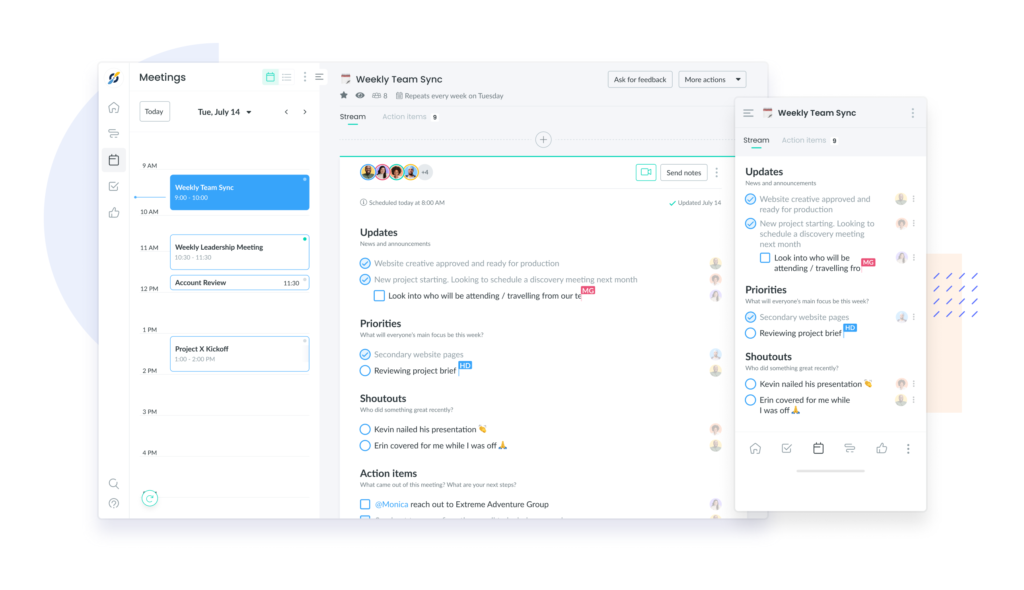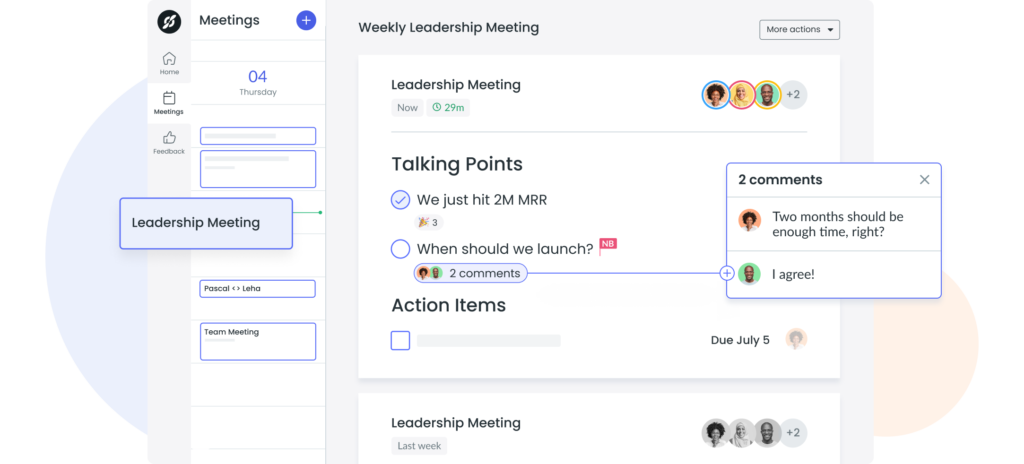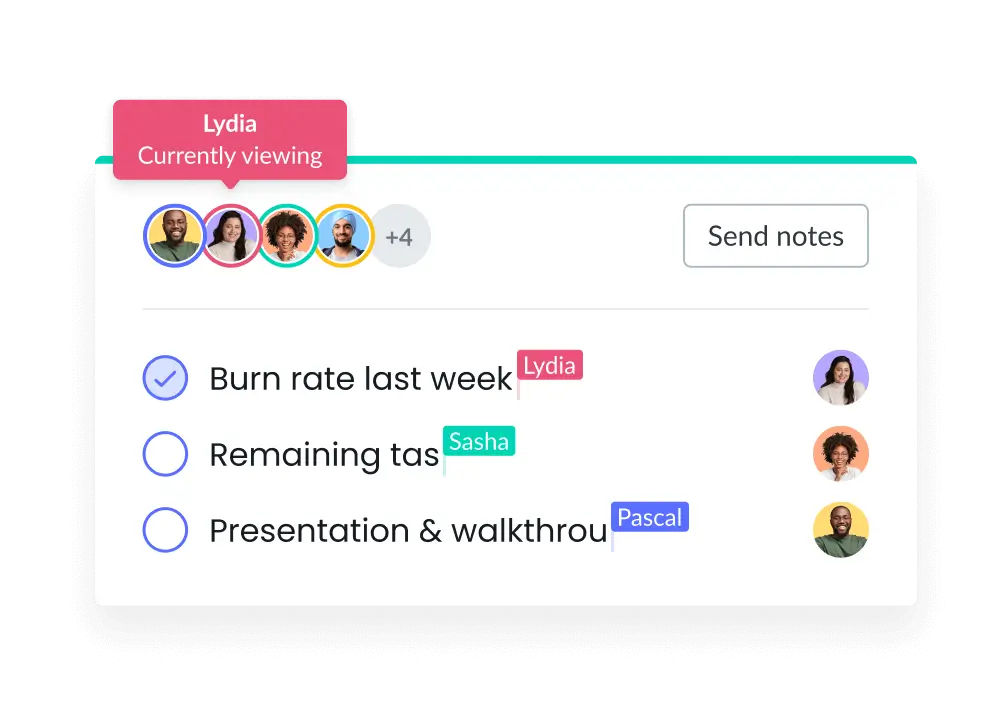All-Staff Meetings: Tips to Make Them Effective (and Top Mistakes to Avoid!)
Learn how to put together an effective staff meeting to boost morale, team engagement, and productivity.
Company-wide meetings tend to be a huge hit or miss because it’s tough to bring together the entire organization without the meeting dragging on or losing focus. That said, an all-staff meeting is important because it boosts morale and motivation, so long as they’re executed effectively. An all-staff meeting aims to highlight company goals to all team members and explain how each individual is valuable, contributing to the attainment of those goals.
In order to prepare you for an effective all-staff meeting, Fellow has prepared the top tips to make this type of meeting effective and we’ve also included some mistakes that you should avoid. Check them out below:
- What is an all-staff meeting?
- Why you should run an all-staff meeting
- Follow these best practices
- Tips to make your meeting more effective
- What to avoid in all staff meetings
- What should be covered in an all-staff meeting
- All-staff meeting template
What is an all-staff meeting?
An all-hands meeting simply means a company-wide meeting, where all of the employees are invited to attend. These meetings bring the whole team together to check in with each other, communicate status updates, progress, any obstacles that need to be overcome, and to track goals. Basically, they keep the whole team on the same page and in the know.
When properly organized and executed, an all-hands meeting can increase engagement, motivation, accountability, and promote creative thinking. Sharing progress is motivating and helps bring team members together to promote an engaged workforce and strong company culture.
Why you should run an all-staff meeting
You should run an all-hands meeting because it brings the whole group together, which probably doesn’t happen very often. This is an opportunity for team members to interact with individuals they don’t typically get the chance to speak with and to expose any level of employee to the senior leadership team. This gives everyone a voice and allows the whole team to be seen and heard.
This type of meeting is a great chance for employees to get answers to any questions they may have and to gain a stronger understanding of how the company operates and creates strategies to attain organizational goals. Including the whole team in discussions and decisions is also going to increase team morale, motivation, and productivity.
Follow these best practices to organize your first all-staff meeting
1 Announce the purpose of the all-staff meeting
It’s really important for you to communicate why you’re bringing the entire company together. Make sure that you announce the purpose of the meeting so that everyone can come feeling prepared, ready to participate, and confident in the questions they want to ask.
2 Choose a meeting template or format
Make sure to choose a meeting template or format to follow so that you keep the discussion on track and focused. Using a staff meeting agenda is a great way to make sure that you stick to the main agenda items and the time that is allocated to each topic. With so many people in the room, it’s easy to get off track.
3 Ask staff to populate the meeting agenda
Ask your team members to populate the company meeting agenda with items that they feel would be important to include. This promotes collaboration and gives everyone a chance to offer their input and insights.
4 Record discussion items, decisions, and action items
Before the meeting, assign someone to take meeting minutes so that you can record all of the key discussion items, any major decisions, and action items with due dates and the person who has been assigned. This serves as a historical record of the discussion that can be referenced in the future or for those who were unable to attend.

Pro tip
Use a meeting management software like Fellow for your all-staff meetings to incorporate the checklist above in a seamless and effective way!

5 Tips to make your all-staff meetings more effective
1 Use a meeting template
Do not conduct an all-hands meeting without a meeting template. Consider sending your staff meeting agenda in advance and asking your team to contribute any items that they would like to be addressed. The meeting agenda or template is going to ensure you keep on topic, on track, and on time.

2 Start on a positive note
Consider starting the meeting with any positive news, team accomplishments, shoutouts or wins. This is going to set the tone for the rest of the meeting and leave your team feeling proud of their work, further motivating them to deliver.
3 Encourage staff to show-and-tell their work
Encouraging your team to show and tell their work is a great idea. If your employees are proud of their work, chances are the rest of the team is going to be proud of them as well. Giving that recognition to your colleagues is important to boost morale and will encourage others to share their work as well.
4 Leave time for questions
Make sure that you’re leaving sufficient time for employees to ask questions at the end of the meeting. In fact, a section of your staff meeting agenda should be dedicated to asking questions. It’s important to show your team that you are there to clarify anything for them and that you have put time aside to address any questions or concerns your team may have.

5 Ask for feedback about your all-staff meeting
It’s a great idea to send out a quick electronic survey after your all-staff meeting so that you can get some honest feedback on how it went. Feedback in this instance is extremely valuable in order to make modifications and improvements before your next company-wide meeting.

What to avoid in all staff meetings
1 Don’t be the only one speaking
This isn’t a presentation so make sure that you’re not the only one speaking! The point here is to foster an inclusive environment where the whole team feels comfortable to contribute and share their ideas and insights. Make sure that you give the opportunity to hear from several different people, preferably, from different streams of the business.
2 Don’t go off on a tangent, follow the agenda
Follow the meeting agenda and be careful not to go off on a tangent. Anything that you’d like to discuss that isn’t on the agenda can be brought up another time, whether you choose to have another meeting or engage in more of an informal discussion.
3 Don’t interrupt people
Harness your self-awareness and be careful not to interrupt your team members. Although typically unintentional, it can look like what they have to say isn’t that important. Show everyone the respect they deserve while speaking and simply jot down your comments or questions in your notes so that you can bring them up later.
4 Don’t start or end late
Be punctual. This sets the right standard of meeting etiquette for the rest of your team and it also shows each attendee that you value their time that they’ve set aside to attend and participate in the meeting. Don’t wait for anyone to begin as it sets the wrong precedent.
What should be covered in an all-staff meeting
Here are a couple of things that we recommend covering in an all-staff meeting. These are the main topics that you can personalize depending on what you feel is most important to discuss. (Scroll down to see our staff meeting template!)
- Good news and wins: Share some positivity with your team to set the tone for the rest of the meeting.
- Shoutouts for other teammates: Make sure to recognize a job well done! Give shoutouts and ask for your team members to also give shoutouts to their team members to boost morale.
- Insights and FYIs: Any kind of progress on projects and updates should be shared here. If you have any metrics that explain your progress, be sure to share them with your team.
- Presentations and demos: Use visual aids to engage participants and to foster a deeper understanding of any insights and FYIs that you’ve provided.
- Questions: Make sure to always leave time for questions so that everyone feels seen, heard and valued.
All-staff meeting template
In order to support you as best as we can in conducting an all-staff meeting, we’ve put together a free template for you and your team. Consider trying this the next time you have a company-wide meeting and prepare to be pleasantly surprised with the results! Check it out below:

Parting advice
An all-staff meeting is a great opportunity to bring the whole team together and provide company-wide updates, progress, and news. It gives individuals the opportunity to interact with colleagues they don’t typically get the chance to work with and strengthens employees’ knowledge of other streams of the business. An all-staff meeting boosts morale and motivation and fosters collaboration when executed properly, so be sure to follow this guide and use our all-staff meeting template in order to get the most out of your next staff meeting.











